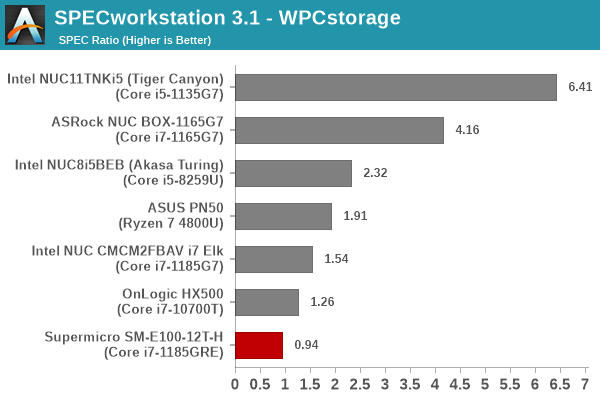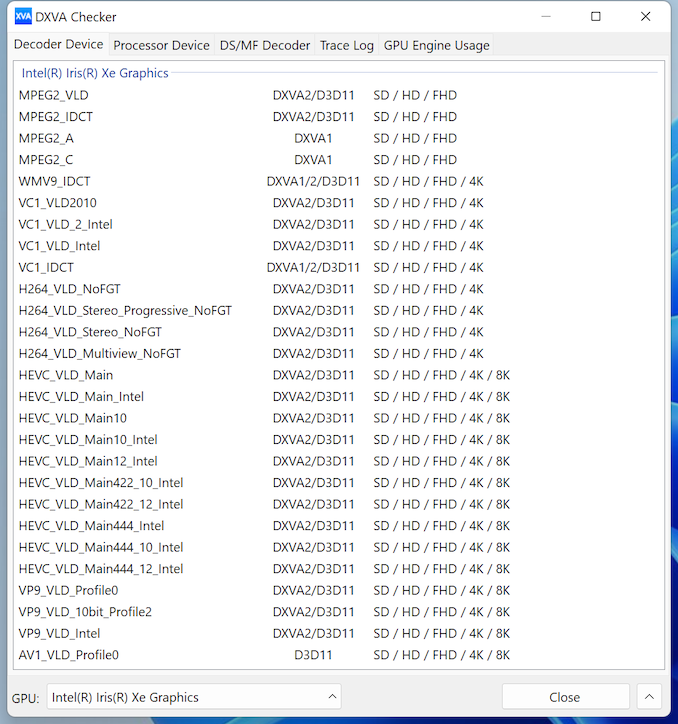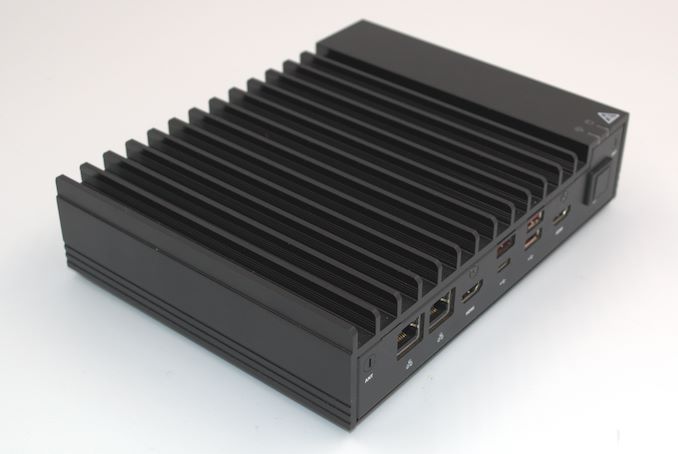Supermicro SYS-E100-12T-H Review: Fanless Tiger Lake for Embedded Applications
by Ganesh T S on June 8, 2022 8:00 AM EST- Posted in
- Systems
- Fanless
- Embedded
- Supermicro
- Passive Cooling
- Tiger Lake
Miscellaneous Aspects and Concluding Remarks
Networking and storage are aspects that may be of vital importance in specific PC use-cases. The Supermicro SM-E100-12T-H allows end-users to integrate their own WLAN and cellular connections if the deployment needs it. In terms of in-built capabilities, the dual 2.5 GbE ports are unique in this market segment (outside of dedicated x86 networking equipment). From a management perspective, the CPU is vPro-enabled - AMT and native dual LAN support allows out-of-band management with a dedicated LAN port, if necessary.
On the storage side, some applications require wide-temperature range and/or high endurance SSDs. The Supermicro SM-E100-12T-H uses a Innodisk M.2 (S80) 3TE7. It is a M.2 SATA SSD with a wide operating temperature change. However, it is no match for the performance provided by NVMe SSDs in other systems. From a benchmarking perspective, we provide results from the WPCstorage test of SPECworkstation 3.1. This benchmark replays access traces from various programs used in different verticals and compares the score against the one obtained with a 2017 SanDisk 512GB SATA SSD in the SPECworkstation 3.1 reference system.
| SPECworkstation 3.1.0 - WPCstorage SPEC Ratio Scores | |||

The graphs above present results for different verticals, as grouped by SPECworkstation 3.1. The storage workload consists of 60 subtests. Access traces from CFD solvers and programs such as Catia, Creo, and Soidworks come under 'Product Development'. Storage access traces from the NAMD and LAMMPS molecular dynamics simulator are under the 'Life Sciences' category. 'General Operations' includes access traces from 7-Zip and Mozilla programs. The 'Energy' category replays traces from the energy-02 SPECviewperf workload. The 'Media and Entertainment' vertical includes Handbrake, Maya, and 3dsmax. Given that the comparison is between a wide range of SSDs in the systems - including both Gen 3 and Gen 4 NVMe, as well as SATA , the relative numbers for most workloads are not surprising. From an embedded PC perspective, the key aspect is the industrial rating / wide operating temperature range for the SSD itself. This ensures ability of the storage device to withstand operation in demanding environmental conditions.
We opted to forego the evaluation of gaming and HTPC capabilities of the Supermicro SM-E100-12T-H - the system is simply not meant for those use-cases. In some circumstances (say, embedded PCs requiring processing of video feeds delivered over the network), the integrated GPU provides excellent decoding capabilities, as evidenced in the DXVAChecker screenshot below. All major codecs ranging from MPEG2 to AV1 are supported for decoding.
The QuickSync capabilities of the iGPU can also be activated - an aspect we quantitatively evaluated in the transcoding benchmarks presented earlier.
Closing Thoughts
The Supermicro SM-E100-12T-H provided us with the opportunity to evaluate Supermicro's 3.5" SBC board for Tiger Lake-U in a fanless chassis. From our evaluation, it is clear that Supermicro delivers effectively on the promise of a high-performance embedded platform. Despite the low TDP of the processor, it is able to deliver compelling performance numbers against much more powerful systems. The platform can also be customized extensively - PCIe slots supporting different form-factors are available to integrate specific WLAN / cellular requirements. Support for analog audio output is also optionally available. There is a wealth of I/O for embedded deployment scenarios. Supermicro is also bringing in some unique features to the embedded market with the SM-E100-12T-H: multiple 2.5 GbE ports and a Type-C port in the front panel.
The only areas of concern that we had from our evaluation was the limiting of the second HDMI port to HDMI 1.4a. Some digital signage deployments could definitely take advantage of multiple 4Kp60 (HDMI 2.0a) outputs. The other aspect is the limiting of the processor TDP to 15W. Given the excellent thermal solution, it is a bit of a surprise as to why Supermicro decided to not be aggressive with the configurable TDP.
On that note, a few comments about the Tiger Lake-U GRE processor series used by Supermicro in the SYS-E100-12T series: These are unique Core processors that have a 15-year availability along with extended operating temperature range (in fact, it is the first one in the high-performance Core family with this type of rating since the Pentium MMX 166). More specifically, Intel guarantees 100% duty cycle for the processor family for 24x7 operation over 10 years across the full temperature range (-40C to 100C). Also making the GRE family suitable for mission critical applications is the support for time-sensitive networking and time-coordinated computing features. The processors also include in-band ECC support (i.e, the ECC data is stored in a separate address space on the same device and is fetched / written concurrently with the primary data). Supermicro's BIOS used for evaluating the SYS-E100-12T-H didn't have an option to turn this feature on - a look at the performance penalties associated with in-band ECC would have been interesting. The Core i7-1185GRE has an operating temperature range of -40C to 100C. However, some of the X12STN board components have a more limited temperature range - the Realtek ALC888S has a 0 to 70C range, while the I225-IT has operating temperature ranges of -40 to 70C for 2.5 GbE and -40 to 85C for 1 GbE. The I226-IT can operate at 2.5 GbE across -40 to 85C, but Supermicro believes the I225-IT is good enough for the X12STN's use-cases, given that the environmental specifications for the SYS-E100-12T-H claim an operating temperature range of -30C to 50C only.
Despite these minor quibbles, we have to say that the Supermicro SYS-E100-12T presents consumers with a wide range of compelling options for industrial deployments. Street prices seem to start around $1216 for the -H variant reviewed here. Other SM-E100-12T options include the Core i5-1145GRE -E version for $1103 and the Celeron 6305E -C version for $593. These prices are par for the course for systems sold in the B2B market. As it stands, the Supermicro SM-E100-12T-H is a solid offering for various industrial and retail applications, medical systems, digital signage, and IoT applications.












16 Comments
View All Comments
kgardas - Wednesday, June 8, 2022 - link
Great little box. Your article although short is very valuable due to your choice of filming going thorough setup. This is a *BIG* thing here. Indeed, due to GRE SoC used I've been very carefully looking into "In-Band ECC" option in the setup. Not seen it anywhere. Perhaps most close but very confusing is "Enable RH Prevention" -- with help text "Actively prevent Row Hammer" -- if this is "In-Band ECC" or not is beyond my imagination -- asking SMicro for clarification would be great here.kgardas - Wednesday, June 8, 2022 - link
Also important question is: country of origin. China or by any chance something more democratic and trustful?nandnandnand - Wednesday, June 8, 2022 - link
Trust No OneSSNSeawolf - Wednesday, June 8, 2022 - link
Supermicro is an American company.kgardas - Wednesday, June 8, 2022 - link
Sure, but a lot of their products are made in P.R.C. Hence caution is reasonable IMHO.andychow - Wednesday, June 8, 2022 - link
Which product isn't made in China? The iPhone is made in China, and so is pretty much every cellphone.Supermicro moved their production from China to Taiwan a couple of years back. There was a rumor that the Chinese government had added a secret chip. Of course, no such chip was ever found on any board, even after Supermicro audited the production and actively investigated. But rumors online stay alive, so they moved to Taiwan.
kgardas - Thursday, June 9, 2022 - link
Majority of Kontron and all Kontron previous Fujitsu boards are made in EU/Germany. Some of Asus/Gigabyte boards are made in Taiwan. Supermicro ordered plans were divided 2/3 in P.R.C 1/3 in Taiwan few years back. Hence the question of coutry of origin.Yes, agree, mobile phone industry is doomed with nearly all P.R.C. production this is why such device can't be tolerated in security sensitive environment.
ricebunny - Thursday, June 9, 2022 - link
If data privacy is your concern than avoiding Made in China products will not help you. Our own government has no shortage of means or moral restraint for that matter to spy on us.Threska - Thursday, June 9, 2022 - link
Why spy on us, when everyone's leaking, even the government.bwj - Wednesday, June 8, 2022 - link
For a box like this is seems like it would have been useful the evaluate the ability of the i225 NICs to move packets. I've had some problems with the i225-v but I don't know if they are universal with the i225 of all kinds.